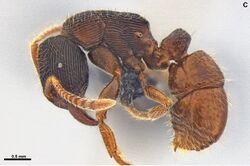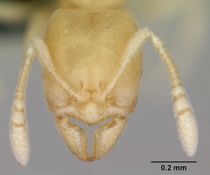Key to Typhlomyrmex workers
This key to workers of Typhlomyrmex species is based on Lacau et al. (2004), Camacho et al. (2020) and Fernández et al. (2023).
Typhlomyrmex foreli is excluded as it is only known from queens.
1
- At least head frons with longitudinal striation or costulation => 2
- Head never with conspicuous costulation, striation, if present, faint and limited to lateral sides => 5
2
return to couplet #1
- In dorsal view, mesosomal dorsum totally sculptured, usually costulate or rugulose => 3
- In dorsal view, mesosomal dorsum with large smooth and shiny areas => 4
3
return to couplet #2
- In frontal view, scape not reaching the vertex margin; metacoxal dorsum with a lobe or denticle; in dorsal view, segments I and II of gaster (abdominal segments III and IV) covered by small ridges or striae, extending from the base of the hairs. Brazil => Typhlomyrmex lavra
- In frontal view, scape slightly surpassing the vertex margin; metacoxal dorsum unarmed; in dorsal view, segments I and II of gaster (abdominal segments III and IV) completely smooth and shiny. Brazil => Typhlomyrmex lenis
4
return to couplet #2
- Pronotum densely punctate, mesosoma lacking any striations; color generally yellow to light brown. Brazil => Typhlomyrmex meire
- Pronotum densely costulate and striate, mesosoma with deep striations; color generally dark brown. Colombia and Venezuela => Typhlomyrmex reichenspergeri
5
return to couplet #1
- Antennae 10 segmented, postpetiole (first metasomal tergum) with a distinct, sharp median carinae on the anterior third of its dorsal surface => Typhlomyrmex prolatus
 Fernández et al. (2023), Figure 3. Photomicrographs of Typhlomyrmex prolatus (CATAC-00879). A, head in frontal view; B, body in dorsal view; C, body in lateral view; D, postpetiolar carinae in dorsal view; E, lateral view. Arrows pointing out the petiolar carinae. Scale bars: 0.25 mm (A, D, E); 0.5 mm (B, C).
Fernández et al. (2023), Figure 3. Photomicrographs of Typhlomyrmex prolatus (CATAC-00879). A, head in frontal view; B, body in dorsal view; C, body in lateral view; D, postpetiolar carinae in dorsal view; E, lateral view. Arrows pointing out the petiolar carinae. Scale bars: 0.25 mm (A, D, E); 0.5 mm (B, C).
- Antennae with more than 10 segments, postpetiole without dorsal median tubercle or carena => 6
6
return to couplet #5
- Anterior face of mesotibia with about 10 denticuliform erect setae (Fig. 4B); mandible shape elongated-subtriangular, their basal margins weakly convex, not reaching the anterior clypeal margin at full closure. Bolivia, Brazil, Colombia, Guiana => Typhlomyrmex clavicornis
 Fernández et al. (2023), Figure 2. Photomicrographs of Typhlomyrmex clavicornis (CATAC-02562). A, head in frontal view; B, body in dorsal view; C, body in lateral view. Scale bars: 0.2 mm (A); 0.5 mm (B, C).Fernández, F., Fiorentino, G. et al. 2023. A new species of Typhlomyrmex from Colombia (10.3897@jhr.96.103219), Fig. 2
Fernández et al. (2023), Figure 2. Photomicrographs of Typhlomyrmex clavicornis (CATAC-02562). A, head in frontal view; B, body in dorsal view; C, body in lateral view. Scale bars: 0.2 mm (A); 0.5 mm (B, C).Fernández, F., Fiorentino, G. et al. 2023. A new species of Typhlomyrmex from Colombia (10.3897@jhr.96.103219), Fig. 2
- Anterior face of mesotibia without denticuliform setae (Fig. 4A, C); mandible shape triangular, their basal margins rectilinear or weakly concave, fitting tightly against clypeus at full closure => 7
7
return to couplet #6
- Petiole well pedunculate in lateral view; node poorly developed, longer than high, subconvex at its top and without a distinct posterior face; abdominal tergite III without obvious anterior face; size polymorphism marked. Neotropics => Typhlomyrmex rogenhoferi
- Petiole weakly pedunculate in lateral view; node well developed, higher than long, well rounded at its top and with a distinct posterior face; abdominal tergite III with a distinct anterior face; monomorphic => 8
8
return to couplet #7
- Metafemora base (posterior view) sharply swollen ventrally, so that it forms a short vertical face at the base, joining the ventral face by an obtuse and rounded angle; head width >0.55 mm => Typhlomyrmex major
- Metafemora base (posterior view) poorly swollen ventrally, so that it does not form an angle at its base; head width <0.55 mm => 9
9
return to couplet #8
- Clypeal lamella bearing a short and narrow median process, protruding, and clearly truncated at the apex (Fig. 5A). Colombia => Typhlomyrmex encanto
- Clypeal lamella not bearing a short and narrow median process (Fig. 5B, C). Widespread => Typhlomyrmex pusillus
References
- Camacho, G.P., W. Franco and R. M. Feitosa. 2020. Additions to the taxonomy of Gnamptogenys Roger (Hymenoptera: Formicidae: Ectatomminae) with an updated key to the New World species. Zootaxa. 4747:450-476 doi:10.11646/zootaxa.4747.3.2.
- Fernández, F., Fiorentino, G., Castro, D. 2023. A new species of Typhlomyrmex from Colombia, re-description of the worker of T. clavicornis Emery, description of the worker of T. prolatus Brown, and key of known species (Hymenoptera, Formicidae). Journal of Hymenoptera Research 96, 579–597 (doi:10.3897/jhr.96.103219).
- Lacau, S.; Villemant, C.; Delabie, J. H. C. 2004. Typhlomyrmex meire, a remarkable new species endemic to Southern Bahia, Brazil (Formicidae: Ectatomminae). Zootaxa 678: 1-23.
















